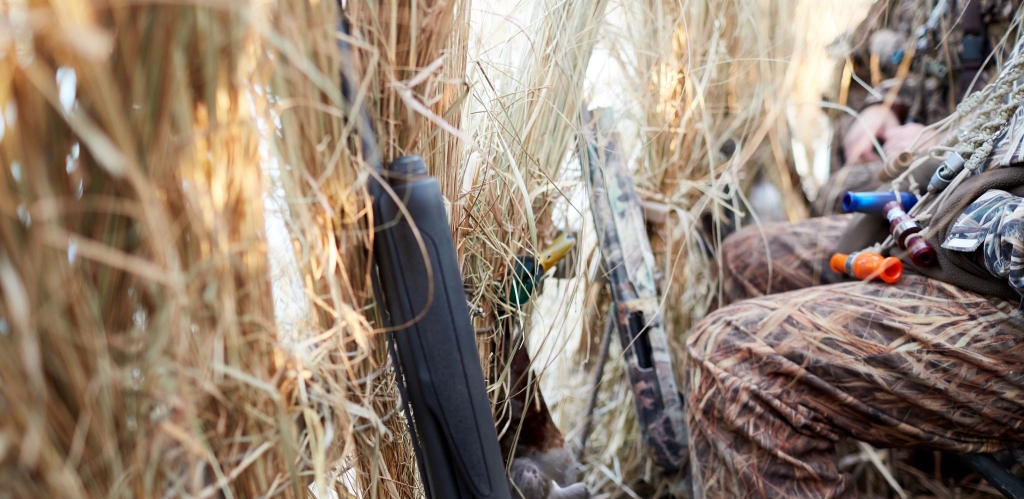Waterfowl Hunting
The DNR reminds Wisconsin that the virus that has caused highly pathogenic avian influenza (HPAI) in wild birds still exists in the state. Information on HPAI can be found on our Avian Influenza webpage.
Season Dates, Regulations and Hours
Wisconsin's waterfowl hunters are some of the nation's most dedicated and involved conservationists. Their enthusiasm and commitment to waterfowl management and habitat restoration make Wisconsin a great destination for waterfowl hunting.
2025 Season Dates
| Early Teal | Sept. 1-9 |
| Early Goose | Sept. 1-15 |
| Rail (Virginia, Sora) | Sept. 1 -Nov. 9 |
| Snipe | Sept. 1 -Nov. 9 |
| Common Gallinule | Sept. 1 -Nov. 9 |
| Mourning Dove | Sept. 1 -Nov. 29 |
| Woodcock | Sept. 20 -Nov. 3 |
| Youth Waterfowl | Sept. 20-21 |
| Northern Duck Zone | Sept. 27- Nov. 25 |
| Southern Duck Zone | Oct. 4 -Oct. 12, Oct. 18 -Dec. 7 |
| Open Water Duck Zone | Oct. 18 -Dec. 16 |
| Coot | *Same as a duck for each zone |
| Northern Goose Zone | Sept. 16 -Dec. 16 |
| Southern Goose Zone | Sept. 16 -Oct. 12, Oct. 18 -Dec. 7, Dec. 20 -Jan. 2, 2026 |
| Mississippi River Goose Zone | Sept. 16 -Oct. 12, Oct. 18 -Dec. 7, Dec. 20 -Jan. 2, 2026 |
Regulations
Visit the Hunting Regulations webpage for the most current document containing a complete list of rules and regulations.
Hunters are reminded to review the waterfowl hunting regulations and are required to carry their small game license and other required stamps or permits, while hunting.
Federal Duck Stamp
Federal Ducks Stamps can be purchased via the Go Wild licensing system (additional processing fees are charged) or at a Post Office. It is required to carry the E-Stamp certification received after your Go Wild purchase when hunting (digital image or hardcopy) or have the physical stamp you have received from the Post Office. If the stamp was purchased from another state's licensing system, you will need to carry the hardcopy E-Stamp certification. Physical stamps must be signed, while the E-Stamp Certification does not need to be signed.
Hours
Hunting hours differ depending on the location in the state. Hunters can use the following documents to look up hunting hours in the part of the state they'll be hunting.
- 2025 Northern Shooting Hours - For the waterfowl and spring turkey seasons.
- 2025 Southern Shooting Hours - For the waterfowl and spring turkey seasons.
Purchase A Hunting License
Wisconsin has made it easy to buy licenses and registrations. Hunters can purchase a small game license and other requisite stamps or permits through their Go Wild account or at a license sale location.
Below is a list of the licenses, registrations and stamps that are needed to hunt the given species. Hunters should verify that they have all these readily available while out hunting this fall.
Migratory Game Birds
| Early Canada Goose | Small Game License, State Waterfowl Stamp, Federal Migratory Bird Hunting Stamp, Early Canada Goose Permit and Harvest Information Program (HIP) Registration |
| Early Teal | Small Game License, State Waterfowl Stamp, Federal Migratory Bird Hunting Stamp and Harvest Information Program (HIP) Registration |
| Duck | Small Game License, State Waterfowl Stamp, Federal Migratory Bird Hunting Stamp and Harvest Information Program (HIP) Registration |
| Regular Goose | Small Game License, State Waterfowl Stamp, Federal Migratory Bird Hunting Stamp, Regular Canada Goose Permit and Harvest Information Program (HIP) Registration |
| Woodcock | Small game hunting license and Harvest Information Program (HIP) Registration |
| Mourning Dove | Small game hunting license and Harvest Information Program (HIP) Registration |
*Persons 16 years of age and older are required to purchase a State Waterfowl Stamp and Federal Migratory Bird Hunting Stamp.
Hunting Programs
Youth Waterfowl Hunt
Wisconsin hosts a Youth Hunt for hunters 15 years old and younger to kick off the waterfowl season each year. All license and stamp requirements for eligible youth waterfowl hunters are waived on these two days. Harvest Information Program (HIP) registration is required of all youth hunters. All other hunting regulations apply, including daily bag and possession limits.
Where To Hunt
Are you looking for a place to hunt waterfowl? Wisconsin offers many areas open to public hunting, including all legally accessible bodies of water. The DNR's public access lands mapping system can help hunters find the perfect spot to hunt this season.
Hunting Safety Tips
Hunters need to follow these safety tips to prevent hunting and boating accidents:
- Be aware that water temperatures are rapidly cooling at this time of year. A fall overboard can quickly turn dangerous as hypothermia sets in. Wearing a life jacket can keep individuals on the surface and allow energy to be used to keep warm rather than to stay above the water.
- Remember to protect canine companions on the water – they need life jackets, too.
- Never overload the boat. If hunting on a large river or lake, use a boat that is big enough to handle rough water.
- Balance the boat evenly and keep weight low for stability.
- Be on the lookout for elements outside your control, such as changing weather or a slightly submerged stump, rock, sandbar or floating debris.
- If you are in a boat or canoe with a hunting partner, establish and communicate a safe fire zone; do not stand to shoot if your partner is shooting from a seated position.
- Know the danger of waders in the water. If a boat capsizes and the hunter is ejected, the waders could fill with water, creating suction around the hunter's legs and feet, making it difficult to remove the waders.
- Always carry a cell phone in case of an emergency.
Additionally, hunters should follow the four rules of basic firearm safety – TAB-K:
- A = Always point the muzzle in a safe direction. About one-third of all hunting incidents are self-inflicted injuries. That means the muzzle was pointed at some part of the hunter's body. A safe approach is where the bullet will travel and harm no one in the event of an unwanted discharge. There are no accidental discharges with firearms, only unwanted discharges.
- B = Be sure of your target and what's beyond it. Positive target identification is a must. To shoot at something you only think is a legal target is gambling. In the case of human injury, that means gambling on human life. You must be specific and correct in judgment before deciding to shoot. Otherwise, it's reckless behavior. In addition to identifying the target, a hunter must know that a safe backstop for their bullet is present in every shooting situation. We don't always hit our target; in some cases, the bullet passes through the target. A safe backstop guarantees that no one will get hurt.
- K = Keep your finger outside the trigger guard until ready to shoot. If a hunter stumbles with a firearm in one hand and nothing in the other, whatever that person does with their free hand will automatically happen with the hand holding the gun. If a finger is inside the trigger guard, that hand will likely close around the gun's pistol grip and on the trigger, causing an unwanted discharge.
- T = Treat every firearm as if it is loaded. Never assume a gun is unloaded, and never treat it that way, even if you watch as it is unloaded. Make it a habit to treat guns like they are always loaded.
Hunter Resources
Becoming A Better Hunter
- Places to Waterfowl Hunt
- The Basics of Waterfowl Hunting in Wisconsin
- The Basics of Dove Hunting in Wisconsin
- Decoy Tactics
- Wingshooting
- Tom Roster's nontoxic shot lethality table
- Wild game recipes provided by DNR staff.
Waterfowl Identification
Dabbling Duck Wing Identification
Diving Duck Wing Identification
Podcasts
Hunters interested in hearing more about game bird hunting, research and tips should listen to The Hide podcast, co-hosted by Mark Kakatsch (Wisconsin Wildlife Federation) and Taylor Finger (DNR Game Bird Specialist).
Also, check out this episode of the DNR's Wild Wisconsin: Off the Record Podcast for a look at the basics of migratory birds in Wisconsin and how to improve your chances this fall.
Invasive Species Management
Visit the DNR's invasive species prevention webpage for more information on invasive species.
Waterfowl Management
The DNR regularly invests in managing waterfowl habitat. Learn more about this work on the DNR's Waterfowl Management and Waterfowl Surveys webpages.
Register A Harvest
Waterfowl and other migratory bird hunters must register each year with the federal Harvest Information Program (HIP), placing them on a list of hunters who may receive a mailing requesting a summary of their harvest. HIP registration is free and can be done at the time hunters purchase their licenses. It can be added later if a hunter decides to pursue migratory game birds.
Hunters who harvest or find banded birds can report their discoveries by following the information listed on the DNR's banded bird recovery webpage.
HPAI Information
In the spring of 2022, a strain of highly pathogenic avian influenza (HPAI) was detected in numerous domestic and wild birds throughout Wisconsin. The virus is expected to continue to circulate in wild bird populations this year.
Hunters should never harvest wild birds that appear sick. HPAI surveillance efforts will prioritize investigating reports of five or more sick or dead waterfowl and waterbirds. If you observe sick waterfowl, contact the DNR's Wildlife Switchboard by emailing DNRWildlifeSwitchboard@wisconsin.gov or leaving a voicemail for a return phone call at 608-267-0866.
This strain of HPAI is not believed to pose a food safety risk. However, hunters should still ensure proper game meat handling and cook harvested birds to an internal temperature of 165°F. Additional precautions include wearing gloves while handling wild birds, washing hands and equipment thoroughly with soap and water and preventing hunting dogs from coming into contact with any sick or found dead birds.
Further information can be found through the U.S. Fish and Wildlife Service, and hunters with backyard poultry flocks can refer to USDA Hunters Protect your Poultry and Pet Birds from AI.
Visit the DNR's Wildlife Diseases webpage for more information on avian influenza and other diseases affecting wildlife health.


